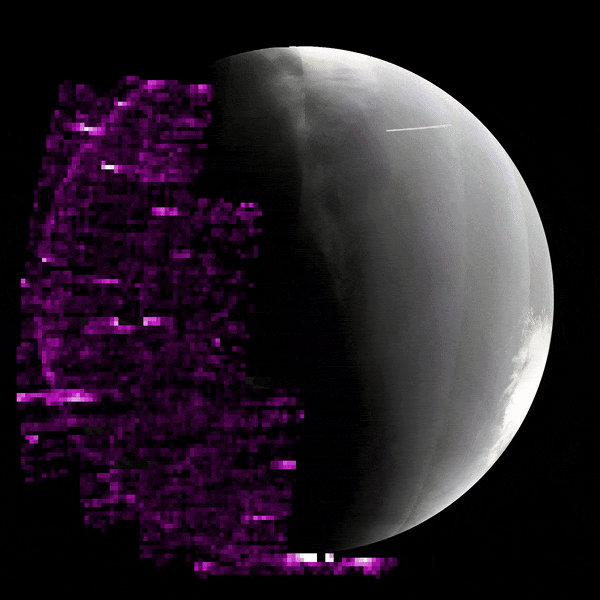Sticks Discovered in Australian Cave Shed New Light on an Aboriginal Ritual Passed Down for 12,000 Years
Both Western analyses and traditional Aboriginal knowledge helped the research team learn about a cultural practice dating to the last ice age
Before the Dinosaurs, This Massive Salamander-Like Predator Ruled Earth’s Swamps
Fossils unearthed in present-day Namibia tell an intriguing story of tetrapod evolution
Alaska's Juneau Icefield Is Melting at an 'Incredibly Worrying' 50,000 Gallons per Second, Researchers Find
Between 2010 and 2020, the icefield lost 1.4 cubic miles of ice each year, according to a new study
NASA Will Pay SpaceX Up to $843 Million to Destroy the International Space Station
After the end of this decade, the company will guide the aging laboratory into the Pacific Ocean, where many retired spacecrafts have been deposited
ISS Astronauts Forced to Briefly Take Shelter as Russian Satellite Suddenly Breaks Up in Orbit
Officials are unsure why the satellite fractured unexpectedly, splintering into nearly 200 pieces
New Blood Test for Predicting Parkinson's Disease With A.I. Shows Promise, Study Suggests
In preliminary research, scientists identified eight protein anomalies in the blood of patients with Parkinson's, which they say can help diagnose the disease up to seven years before symptoms appear
Two Massive Asteroids Will Fly Past Earth This Week. Here's What to Know
Within 42 hours of each other, the pair of large asteroids, which both have no chance of impacting our planet, will approach Earth as they orbit the sun
China Brings Samples From the Moon's Far Side to Earth in First-Ever Feat
The China National Space Administration retrieved more than four pounds of lunar soil samples, which scientists hope will shed light on the early history of Earth and the moon
Extreme Wildfires Became Twice as Frequent and Intense in 20 Years, Study Finds
As measured by satellites, wildfires have markedly increased in boreal and temperate conifer forests, and rising nighttime temperatures allow flames to keep burning intensely after dark
Starliner Astronauts Will Remain on Space Station Until July Amid Technical Issues
NASA and Boeing have delayed the crewed mission's return to Earth again, as engineers assess helium leaks and a thruster issue on the spacecraft's service module
Why Are Some People Seemingly Immune to Covid-19? Scientists May Now Have an Answer
Researchers tracked the immune responses of 16 people intentionally exposed to SARS-CoV-2 and pinpointed a gene that seems to help resist the virus before it can take hold
Extreme Heat and Wildfire Smoke Should Be Considered 'Major Disasters' by FEMA Amid Climate Crisis, Advocates Say
Despite killing more people in the U.S. each year than hurricanes, floods or tornadoes, heat waves aren’t currently eligible for emergency funding from the disaster relief agency
After Months of Glitches and Gradual Fixes, Voyager 1 Is Fully Operational Once Again
Currently 15 billion miles away from Earth, one of NASA’s longest-tenured spacecraft is back from the brink after a technical failure last year put its future in question
Mars Was Hit With a Solar Storm Days After Earth's Aurora Light Show, NASA Says
Studying this event could hold lessons for scientists about how to protect astronauts from radiation on future trips to the Red Planet
A Giant Interstellar Cloud May Have Once Enveloped Earth, Potentially Causing Ice Ages
Astronomers suggest this cold, dense cloud compressed our sun's protective field between two and three million years ago, leaving the Earth exposed to cosmic material
Endangered Wild Horses Return to Kazakhstan for the First Time in at Least 200 Years
The international effort, led by the Prague Zoo, released seven Przewalski’s horses to their native steppe habitat in central Asia
Astronomers Discover Water Frost on Mars' Tallest Volcanoes
On early winter mornings, a thin layer of ice forms in craters atop the Red Planet's towering peaks, near its equator, according to a new study
William Anders, NASA Astronaut Who Captured Iconic 'Earthrise' Photograph, Dies at 90
The Apollo 8 lunar module pilot also served in the U.S. Air Force and worked extensively on nuclear energy projects
When Did Humans Domesticate Horses? Scientists Find Modern Lineage Has Origins 4,200 Years Ago
A new study suggests people in the Eurasian steppe bred horses around 2200 B.C.E., challenging earlier ideas about the beginnings of horse husbandry
Archaeologists Discover Clues to Ancient Migration Route That Brought Humans to Australia
New research offers evidence that humans did not inhabit the island of Timor until around 44,000 years ago, suggesting it was not part of the original migration route from Southeast Asia to Australia
Page 1 of 6
/https://tf-cmsv2-smithsonianmag-media.s3.amazonaws.com/accounts/headshot/ChristianThorsberg_Headshot.png)
:focal(479x324:480x325)/https://tf-cmsv2-smithsonianmag-media.s3.amazonaws.com/filer_public/50/2d/502ddbdd-191f-4d2b-9655-53a207c5f809/australia3.png)
:focal(238x571:239x572)/https://tf-cmsv2-smithsonianmag-media.s3.amazonaws.com/filer_public/a8/f9/a8f99c2a-3eba-4495-99dc-cbbd571e5cac/low-res_1-_gaiasia_lio.jpg)
:focal(1659x1074:1660x1075)/https://tf-cmsv2-smithsonianmag-media.s3.amazonaws.com/filer_public/c1/61/c161fa46-0dbe-4d05-8b13-38fecbcdbca1/50163446722_c9a8225ef9_o.jpg)
:focal(1516x996:1517x997)/https://tf-cmsv2-smithsonianmag-media.s3.amazonaws.com/filer_public/d0/f1/d0f11470-d900-4ca5-9159-6d60c710a179/iss2.jpg)
:focal(960x549:961x550)/https://tf-cmsv2-smithsonianmag-media.s3.amazonaws.com/filer_public/e1/13/e11310c8-6874-4f1f-8a89-a06cc84c9338/geostationary_orbit.jpg)
:focal(1061x707:1062x708)/https://tf-cmsv2-smithsonianmag-media.s3.amazonaws.com/filer_public/71/67/71670cf2-6c5d-41c2-a41b-1ba60b600e07/gettyimages-1348149832.jpg)
:focal(1750x1083:1751x1084)/https://tf-cmsv2-smithsonianmag-media.s3.amazonaws.com/filer_public/90/df/90dfeb2c-1659-4b56-969c-9c4255f9c2f7/space_safety_programme_-_near_earth_objects.jpg)
:focal(2418x1543:2419x1544)/https://tf-cmsv2-smithsonianmag-media.s3.amazonaws.com/filer_public/45/19/45197949-7a36-4024-be92-d772ab33919c/gettyimages-2159261406.jpg)
:focal(1936x1309:1937x1310)/https://tf-cmsv2-smithsonianmag-media.s3.amazonaws.com/filer_public/34/d8/34d88951-5941-4036-8f40-4d616a666e51/4971832860_bb48df3454_o.jpg)
:focal(972x2592:973x2593)/https://tf-cmsv2-smithsonianmag-media.s3.amazonaws.com/filer_public/89/73/8973fbaf-9373-4bff-bfe4-a55de5b94b9b/starliner3.jpg)
:focal(1061x707:1062x708)/https://tf-cmsv2-smithsonianmag-media.s3.amazonaws.com/filer_public/d9/cb/d9cb64a2-b2f5-4169-8c96-077273fab5f2/gettyimages-1287184953.jpg)
:focal(1839x1208:1840x1209)/https://tf-cmsv2-smithsonianmag-media.s3.amazonaws.com/filer_public/13/42/1342b2d5-0415-40f3-9c51-40b49d5f1c2b/gettyimages-2155667570.jpg)
:focal(4096x2321:4097x2322)/https://tf-cmsv2-smithsonianmag-media.s3.amazonaws.com/filer_public/c1/85/c185108a-791f-4610-9084-98dcb2c0a49a/voyager2.jpg)

:focal(537x445:538x446)/https://tf-cmsv2-smithsonianmag-media.s3.amazonaws.com/filer_public/e8/b6/e8b68174-1c9b-465e-8469-b66151dd09fa/heliosphere.jpg)
:focal(1024x692:1025x693)/https://tf-cmsv2-smithsonianmag-media.s3.amazonaws.com/filer_public/5e/14/5e14813f-4ff1-4092-8f2a-196a96b0885b/prz_horse.jpg)
:focal(845x459:846x460)/https://tf-cmsv2-smithsonianmag-media.s3.amazonaws.com/filer_public/ef/ff/efffec3e-d663-4701-8116-ec653f5d3ca9/perspective_view_of_frosty_olympus_mons.png)
:focal(521x421:522x422)/https://tf-cmsv2-smithsonianmag-media.s3.amazonaws.com/filer_public/f7/13/f713a3c3-0c17-47dc-b4be-2eb7de52ce8d/anders6.webp)
:focal(547x365:548x366)/https://tf-cmsv2-smithsonianmag-media.s3.amazonaws.com/filer_public/d7/35/d735b96e-784a-4513-a57d-55eaf47ce53f/imagechevaux.jpg)
:focal(590x332:591x333)/https://tf-cmsv2-smithsonianmag-media.s3.amazonaws.com/filer_public/df/49/df493f8a-5c9b-4699-b052-a58b25f91ae7/australia3.jpg)